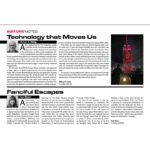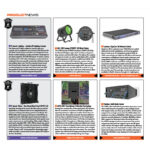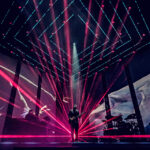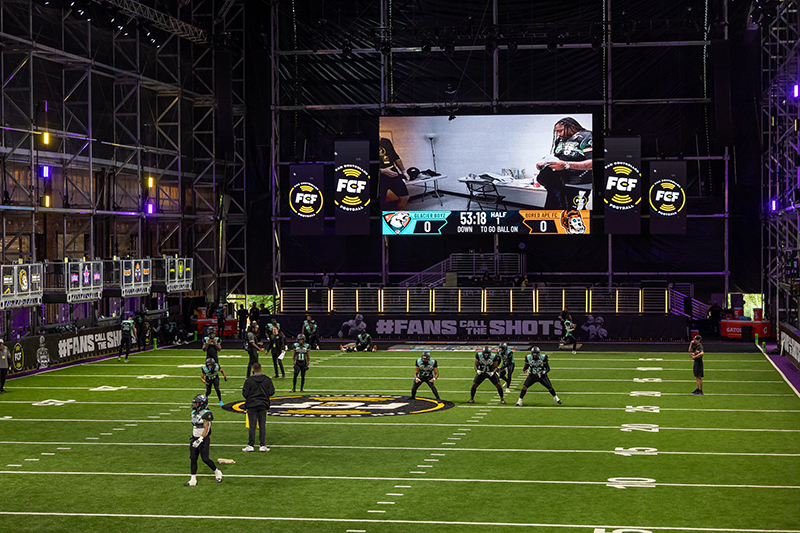
With the successful completion of Season Two of Fan Controlled Football (FCF), armchair quarterbacks everywhere can sit back and know that everything is right with the world. FCF is football re-imagined for the modern digital world with the use of patented technology that allows fans to call the shots. These are real games played in a single, high tech studio arena and streamed live on Twitch, NBCLX Peacock, and FUBO Sports Network.
Season One of FCF stormed the field at Infinite Energy Center in Duluth, GA in the spring of 2021 with a six-week season that culminated in the People’s Championship. Discussion on creating a Season Two began practically before the confetti hit the playing field at the end of the game. During the pandemic it wasn’t easy to find a venue that had a 12-week block open and that could be viably secure in maintaining a Covid-free environment. So the FCF found a space where they could build the venue they required.
The entire live environment design for Season Two was created by Production Designer / Production Manager Tom E. Marzullo. He headed up a team that brought it all together in Atlanta at the Pullman Yards, the site of Season Two’s arena. Executive Producer, Luke Arnold, is ultimately responsible for how the broadcast looks as it streams into homes around the world. “With a sports league like FCF, which is on the cutting edge of what we used to think of sports events, it is very important that the venue reflect that,” notes Arnold. “Tom Marzullo has done an amazing job of intricately combining that forward-thinking 21st century look we wanted while preserving the historic ambiance of the Pullman Yard site. It is a unique venue; perfect for our league.”
COO Cyrus Farudi comments, “Tom has been able to listen to us, understand what we are trying to do in a way that very few people have been able to. Then he is able to absorb all that, conceptualize it, put it into renderings, and ultimately a set design that meets with our vision. With Pullman as a backdrop, Tom achieved that dystopian futuristic Blade Runner meets cyborg-like industrial feel we were looking for. It’s not like we spent 40-hour sessions repeatedly discussing this in detail. We’re talking a couple of half hour phone calls. Then he came back with an inspiration board with, ‘Is this the right direction?’ I don’t think we ever said no.”
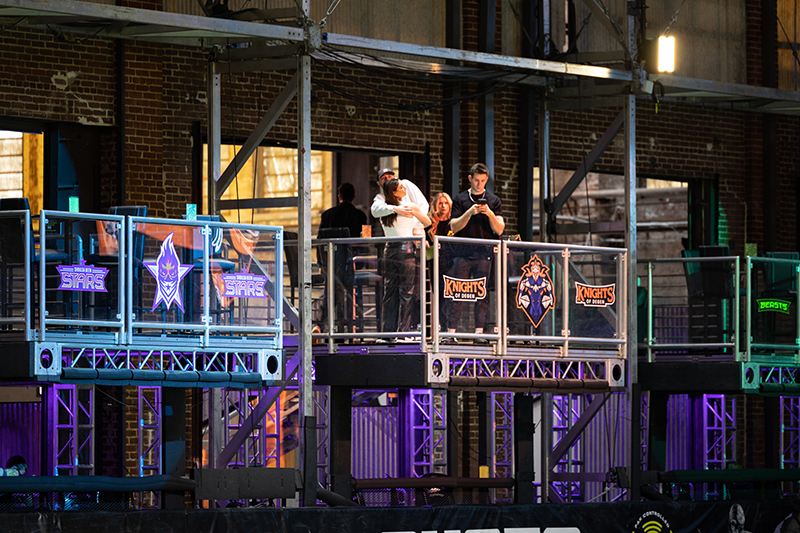
Historic Location
This historic Pullman Yards property, located in Atlanta, GA, was originally built in 1904 by Pratt Engineering for the production of munitions during WWI. Later it was used to develop liquid carbonated gasses, which were purchased by The Coca-Cola Company. In 1926 the Pullman Company, renowned for luxurious rail travel, purchased the property, expanded it and gave it its iconic name, using the site to repair passenger and cargo cars. After being dormant for years, in 2017 the site was purchased by Atomic Entertainment, who have redeveloped it as an “entertainment destination of the South” serving as a creative and cultural focal point.
This has ushered in a new era for the Pullman Yards, which are now used for film and television productions. Still, buildings Two and Six, which would ultimately be converted into the arena and broadcast facilities, needed major overhauling to be usable by the FCF. Trees were growing through the floor and vegetation was rampant throughout the old steel foundations.

The Build
Marzullo called up Robert Achlimbari of All Access Staging & Productions, whom he has worked with on a myriad of projects over the years. “With anything Tom and I talk about, it’s always about the sheer scale of the project,” says Achlimbari. “The simple practicality of creating a weatherproof environment for the performers, the players, the field, the spectators, and all the production elements on this took another whole dimension on when we added in the factor that this was a historical site with some very rigid restrictions on how we approached the build.”
Chief among these was the fact that none of the materials brought onto the site could touch any of the original structure. Everything had to stand independently of the Pullman structures. And the All Access structures had to remain independent of the roof structure provided by AG Production Services, whom Marzullo brought in to solve the environmental protection issues. Protecting the floors of the buildings required a special cement compound pad to be laid down as a barrier. All truss, scaffold, grandstands, and stage had to have a minimal space between vendor materials and the historic structure.

Load-in commenced in January of 2022. Building Two is where the VIP suites bridges between interior and exterior, as well as housing the practice field, Esports gaming area, and various hospitality suites. As these were all known elements, Achlimbari had the All Access crew begin there. On the site walk through with the property owners, he recalls, “I could tell they were very excited about the concept, though a bit taken aback when they started realizing the scope of what we were about to do.”
The mainstage [the field] came into play once the outdoor structures and field dimensions had been sorted out. Building Six was the last area they worked on. “We had a game plan going into this project and although there was a lot of fine tuning as we got further into it, the fact is the load-in went remarkably smooth,” states Achlimbari. Marzullo adds, “We literally built this thing from scratch, from the ground up. Really, every day as we peeled away another layer to put something in place we discovered another issue that had to be resolved before forward progress could be made.”
AG supplied the domed roof structure and the grandstands. All Access provided everything else—platforms, The VIP and hospitality suites, the mainstage [the field], and the DJ booth. All Access also supplied the tech platforms in building Six, and the rolling stage platforms that served as performance areas for the halftime show. These were replicas in miniature of the same rolling stage All Access have provided for the halftime show at the Super Bowl for the last 12 years. The All Access’ brand, Versa Stage® Systems were the materials used throughout and All Access’ support depot in Atlanta played a part in staging of materials for this project. “Everyone worked well together and everyone one bought ideas to the table,” describes Achlimbari. “Projects with Tom are always fun—some small, mostly large, but always interesting!”
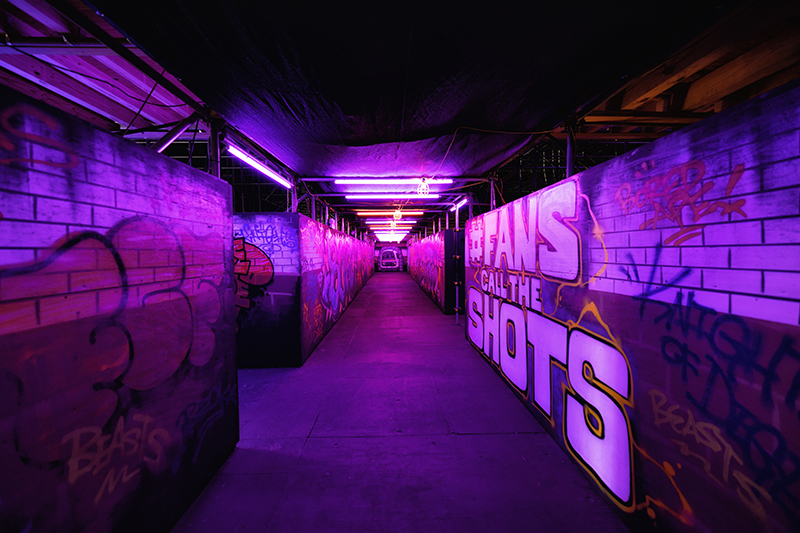
Lighting
“The first task for us,” says Todd Finch, President of the Magnum Companies, the lighting vendor for the FCF project, “if not the only task, was the fact we needed sports-level broadcast lighting. The artistic aesthetics was a sidecar to that. Elation had just come out with their Proteus Maximus, and they provided a lot of photometric testing to meet that spec.” [For more on the field of play lighting testing, see the sidebar on page 29.] Ultimately 124 Proteus Maximus units were hung for the show.
The lighting design originated first from Marzullo, who brought the broad brush strokes to the table to establish a camera-friendly broadcast look that could morph into entertainment lighting during the game itself or a DJ and band lighting system for the halftime show. To realize that design scope Finch suggested the Elation units. While during the game play, the 124 Elation Proteus Maximus luminaires provided an even wash of white light at the proper illumination levels for the broadcast cameras, the idea behind using the Proteus Maximus was that they would really bring up the energy, the excitement, and the visual interest of play. Every time something exciting happened, like a touchdown, they were able to take the entire field and create different lighting effects. The lights could also be fully used to provide all the performance looks—color, gobo, effects, etc.—for the DJ or during the halftime show in conjunction with the rest of the lighting package.
“That is the beauty of the Marzullo touch,” enthuses Finch. “He brings showmanship to what would normally be a simple sports light rig. We have the Elation Cuepix Blinders, the Chauvet Color STRIKE M strobes, and Astera Titan Tubes in the rig. Every fixture is at least doubly purposed, with the Proteus doing the heavy lifting regarding artistic gobo, color, and FX as well as the broadcast level of lumens.” There was also a tremendous amount of data networking going on at the site, of which Magnum kept all their signal flow separate and hard-wired for serviceability.
Video
Executive Producer and Game Day Producer Roddy White of RFW Solutions explains the video server setup, “Utilizing the new Mac Studio M1 chipset in combination with Renewed Vision’s ProVideoPlayer (PVP) 3 software the video team is pushing two 4K destinations, and three 1080 destinations, as well as ingesting five 1080 video sources for a total of 33 million pixels.” White continues, “Additionally, the Mac Studio is using a combination of Blackmagic Design Decklink 8K Pro, and Decklink Quad 2 for the I/O routed through a Blackmagic Design Smart Videohub 12G 40 x 40 router. All equipment is under network control through Bitfocus’ Companion and a set of four Elgato Stream Decks. Using Syphon and NDI we are able to bring in emoji responses from the Twitch live chat during games for display on the endzone screens.”
Johnny Vickers with IC LED had been on board with FCF since v1.0 “It’s a very ambitious design he has at Pullman,” Vickers notes. “Tom took me down there before restructuring started and I liked the feel of the buildings. It was just hard to envision what this was going to be. The venue is amazing. It allows us to have 1,500 or more guests come in, but also allowed for a custom build for the video displays. When you see the broadcast, it’s hard to be at any angle that you can’t see the video. It’s a very pumped-up sporting environment. The whole production, and feel of the place, is amazing because of the way Tom combined the audio, the lighting, and video.”

Field of Play Lighting
For the field of play lighting, Todd Finch, President of the Magnum Companies suggested that they use a traditional moving light—the Elation Proteus Maximus—to do both duties. Bob Mentele, Specification Sales for Elation, told PLSN about the testing process to choose the right number of units needed.
We tested the Elation Proteus Maximus to properly illuminate the field of play for the Fan Controlled Football broadcasts and we determined that they would need at least 110 of the Proteus units to get the correct light levels for the games. [In the end, a total of 124 units were used for the field lighting.] In the initial pass, we started with 75 fixtures which produced 75 footcandles evenly across the field. A good starting point, but they were looking for 100 – 125 footcandles. We increased the quantity of units to 110 and produced an average of 150 footcandles, more than they would need.
To calculate the lighting coverage for the field of play, I used DIALux software, which is actually intended for architectural lighting design. It’s more granular in its photometric measuring capabilities than other programs we may use like Vectorworks, Capture, or Revit. They use a very generalized photometric measurements, which in some cases may work, but in cases like this for a field of play, we need to be able to measure points of light in a much more granular grid form. The downside of using DIALux is it is reliant on IES files; a snapshot of a fixture. In architectural lighting, most times the fixtures are static that produce one angular dimension of light. The difficulty with DIALux—in this situation—was we had this field of play, and it’s a large field of play, and we’re using 110 different lighting fixtures, that are not all going to be at one beam angle, at one intensity at one angle, or at one pan and tilt angle.
Fortunately, the Elation photometrics lab was able to do the measurements we needed. I don’t think we could have gotten the granular information that we did without their help. All told, we spent about 40 – 60 hours on the modeling and testing to make sure we had every angle covered and lit properly. The Elation Proteus Maximus was a good choice for the field of play light, and I am glad we were able to provide the data they needed to realize the design for this broadcast.
Fan Controlled Football, Season v2.0
April 16-June 11, 2022; Pullman Yards, Atlanta, GA
Production Team
- Production Designer/Live Production Manager: Tom E. Marzullo
- Production Coordinator: Jennifer Kreps
- Lighting Designers: Tom E. Marzullo, Todd Finch, Taylor Chandler
- Consulting Lighting Designer (Broadcast and Live): Andrew Giffin
- Broadcast Lighting Designer: Rick Smith
- Lighting Programmers: Taylor Chandler, Andrew Giffin
- Pre-Viz: Bryan Hartley, Michael Keller
- Video Screens Lead Systems Tech: Bubba Ress
- Video Techs: Kirby Vickers, Tariq Jones, Johnny Vickers
- Head Carpenter: Dan Prince
- Set Carpenters: Colin McCord, Daniela Macallum, Dan Alvarado, Dristian Bailey, Asa Stepens, Jackson Bernhardt, Ambrose Ross, Otto Albert Stoy III, Matthew Daves
- Lead Riggers: Tom Cusimano, Jimmy (JR) Reynolds
Vendors
- Lighting: Magnum/Todd Finch
- Staging: All Access/Robert Achlimbari
- Video: IC LED Johnny Vickers
- Scenic: McCordCo, Mecca, & Atomic
- Roof Structure: AG Production Services
Gear
Lighting
*Main Field:
- 1 MA Lighting grandMA2 full-size Console
- 1 MA Lighting grandMA2 NPU
- 2 MA Lighting grandMA3 4 Port Node
- 2 MA Lighting grandMA3 8 Port Node
- 124 Elation Proteus Maximus
- 40 Chauvet Color STRIKE M
- 2 Robe BMFL WashBeam
- 24 Astera Titan Tube
- 10 Elation Cuepix Blinder WW4
- 8 Elation Cuepix 16IP
- 1 Robe RoboSpot Base Station
*Building Two:
- 1 MA Lighting grandMA2 Dot2
- 108 ETC Source Four Ellipsoidal
Video
- 10 VISS by Absen VX5 5.7mm LED Screens, Flown
- 5 VISS by Absen VX5 5.7mm LED Screens, Custom Mounted
- 1 VISS by Absen VX5 5.7mm LED Screen, Ground Supported
- 25 65” HD Monitors
- NovaStar 4K Processing
